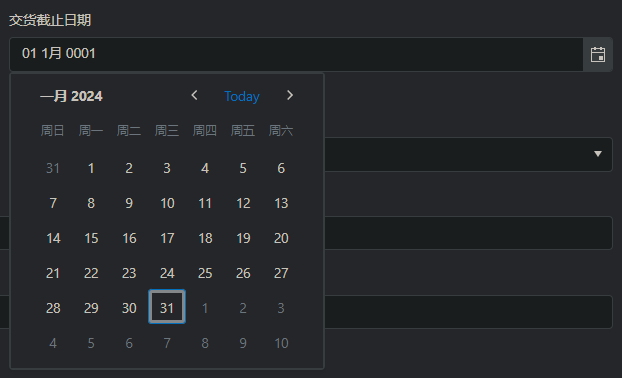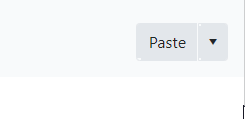Hello,
I'm using a numeric textbox and when I test my page for accessibility, Allyable reports the following:
Category: Ensure button or link have discernible text that is not repeated as image description
Selector: .k-form-field-wrap > .k-numerictextbox.k-widget > .k-numeric-wrap > .k-select > [role="button"].k-link-decrease
Severity: Critical
Here is my source code:
<TelerikNumericTextBox @bind-Value="@cardCleaner.Quantity" Id="cleanerQty" Width="100px" />
Is this really an accessibility issue?
Thanks,
Bernard
Hi,
As the subject says, when our app is on the Chinese localization `zh-CN` it causes the date picker to default.
By default I mean the default date becomes 01 01 0001 and you cannot change it no matter what you select.
On any of our other localizations such as es-ES, en-US, fr-FR, etc. (zh-CN is the only one is what I'm getting at) we don't get this issue.
For reasons unknown, our TelerikGrid rows all render with each <tr> element having the "k-alt k-table-alt-row" classes associated with them. This causes the background colour for each row to be the same, rather than alternating between two colours.
For example, the following block of code...
<TelerikGrid Id="@(Utility.CleanCssId("CrewGrid"))"
DetailTemplate="GridDetailTemplate"
EnableLoaderContainer="@ShowLoading"
Groupable="false"
Height="100%"
OnRead="@OnGridRead"
OnStateChanged="@OnGridStateChanged"
OnStateInit="@OnGridStateInit"
Pageable="true"
PageSize="@PageSize"
PageSizeChanged="@OnGridPageSizeChanged"
Reorderable="IsLargeScreen"
Resizable="IsLargeScreen"
SelectionMode="GridSelectionMode.Single"
ShowColumnMenu="IsLargeScreen"
Size="@GetGridSize"
Sortable="true"
SortMode="SortMode.Multiple"
TItem="CrewListItem"
@ref="Grid"
@bind-SelectedItems="@SelectedItems"
OnRowRender="OnRowRender">
<NoDataTemplate>
<strong>@RecordsMessage</strong>
</NoDataTemplate>
<GridSettings>
<GridColumnMenuSettings Lockable="false" FilterMode="ColumnMenuFilterMode.None" />
<GridPagerSettings InputType="PagerInputType.Buttons" PageSizes="@PageSizes" ButtonCount="5" Adaptive="false" Position="PagerPosition.Bottom" />
</GridSettings>
<GridColumns>
<GridColumn Field="@nameof(CrewListItem.Color)"
Width="@(IsLargeScreen ? "40px" : "50px")"
Resizable="false"
ShowColumnMenu="false"
Groupable="false"
ShowColumnChooser="false"
Sortable="false"
HeaderClass="k-text-transparent"
OnCellRender="OnGridCellRender">
<Template>
@{
var item = (CrewListItem)context;
<M360ListColumnColor Color="@item.Color" IsLargeScreen="IsLargeScreen" />
}
</Template>
</GridColumn>
<GridColumn Field="@nameof(CrewListItem.Name)" Title="@TMessages.Crew" OnCellRender="OnGridCellRender" VisibleInColumnChooser="false">
<Template>
@{
var item = (CrewListItem)context;
<div class="k-d-flex k-h-full @(IsLargeScreen ? "k-align-items-stretch" : "k-align-items-center")">
<M360ListColumnLink Url="@string.Concat("crew/", item.Id)" Text="@item.Name" EntityType="Crew" IsPrimary="true" />
</div>
}
</Template>
</GridColumn>
<GridColumn Field="@nameof(CrewListItem.DivisionsJson)" Title="Division(s)" Sortable="true" Visible="IsLargeScreen" OnCellRender="OnGridCellRender">
<Template>
@{
var item = (CrewListItem)context;
<M360ListColumnList Items="@item.Divisions.ToList()" />
}
</Template>
</GridColumn>
.
.
.
</GridColumns>
</TelerikGrid>...results in markup like this...
<tbody class="k-table-tbody" role="rowgroup">
<tr
role="row"
class="k-master-row k-table-row k-alt k-table-alt-row"
data-render-row-index="0"
aria-rowindex="1"
>
. . .
</tr>
<tr
role="row"
class="k-master-row k-table-row k-alt k-table-alt-row"
data-render-row-index="1"
aria-rowindex="3"
>
. . .
</tr>
<tr
role="row"
class="k-master-row k-table-row k-alt k-table-alt-row"
data-render-row-index="2"
aria-rowindex="5"
>
. . .
</tr>
. . .
</tbody>
I can see that the "aria-rowindex" increments by two, yet the "data-render-row-index" increments by one. Are we missing something simple, yet crucial here? What could cause the skipping of rows during render?
Many thanks,
Nem
ValueExpression="@(() => AttendanceDTO.WorkScheduleEndTime)"
AdaptiveMode="@AdaptiveMode.Auto"
ValueChanged="@( (DateTime d) => ChangeWorkScheduleEndTime(d) )"
Format="dd/MM/yyyy (dddd) HH:mm"
Id="selected-date"
Enabled="!ReadOnly">
</TelerikDateTimePicker>
When I click on any item from the SplitButton dropdown list, it closes, until I release the key
Filter option switch back to default option (Contains) after entering value in the textbox.
Example -
- screenshot-1 - Select from filter option - Startswith ; Then, enter value in text box.
- screenshot -2 - After user enter first character , atomically filter option switch back to Contains (from startswith).
After upgrading to Telerik Version 3.6.1 my CSS is messed up on my grids, the pagers look like the image below.
As an extension to a context menu a radial menu control would be a nice addition.
https://ux.stackexchange.com/questions/25002/are-circular-menu-button-interfaces-intuitive

Please add the option for the Multiselect to filter the same way the DropDownList does. It's very odd & confusing for end users (and bad UX) in a UI toolkit for similar controls to do things in different ways. Can you please add the ability for the Multiselect control to filter items in the popup window the same way the DropDownList does with the nice filter text box.
We have a form with multiple TelerikEditor controls bound via @bind-value. The issue arises when there are more than 2 TelerikEditors; the performance is significantly impacted for all input fields. Typing experiences delays, making fast typing impractical.
This performance degradation is attributed to the fact that the page undergoes frequent re-renders when typing into the input fields. Interestingly, this behavior does not occur when TelerikEditor is excluded from the form or page.
While the DebounceDelay property in TelerikEditor helps improve its performance, it does not extend its influence to other input fields in the form or page. Are you familiar with this issue, and do you have any recommendations for addressing or mitigating it?
Using:
WebAssembly
Telerik 4.0.1
If the Datepicker's binded value is a DateOnly type, the Min and Max should follow that type.

Hello,
I would like to have a parameter to show or hide a clear button on TextBox.
regards
Hi, I just came accross a bug in the TelerikStepper.
I try to create a custom version that switches to a custom success icon after a step is completed.
It contains the following codesnippets:
<TelerikStepper Linear="true" ValueChanged="@HandleValueChanged">
<StepperSteps>
@for (int i = 0; i < IsValidArray.Length; i++)
{
<StepperStep Valid="@IsValidArray[i]"></StepperStep>
}
</StepperSteps>
</TelerikStepper>
@code {
bool?[] IsValidArray = [null, null, null, null];
public void HandleValueChanged(int index)
{
for (int i = 0; i < IsValidArray.Length; i++)
{
IsValidArray[i] = index > i ? true : null;
}
}
}
Forward it works like expected:
When moving backwards it behaves strange:
Except if you are debugging (Visual Studio debugger), then everything works as expected:
Same thing can be achived when not debugging but clicking on the step a second time.
This can not be solved by adding the @key parameter as suggested in https://feedback.telerik.com/blazor/1659827-bug-in-the-telerikstepper-in-blazor from Hristian Stefanov!
Nevertheless, it turns out that the Task.Delay(1); seems to solve the Issue somehow.
Is this intended?
When I place a tooltip on drawer item, it just flickers randomly
![[video-to-gif output image]](https://im3.ezgif.com/tmp/ezgif-3-4372cd0f87.gif)
https://blazorrepl.telerik.com/wQbbmbGb05hzznPh45
When viewing the documentation ( https://docs.telerik.com/blazor-ui ), it would be great to be able to run the code from my browser, just like https://www.w3schools.com/cs/index.php which allows you to run, play and preview the code from the website.
The reason this is so important is that people will be able to quickly test and try out variations of the demo code and do a quick test to see if they got it right. Right now I either have to load the demo solution, make changes, compile the entire solution just to try small changes to the sample code, and then end up corrupting the demo solution.
I think this would be a great feature for all the demos that would support it. And set you apart from your competition.







